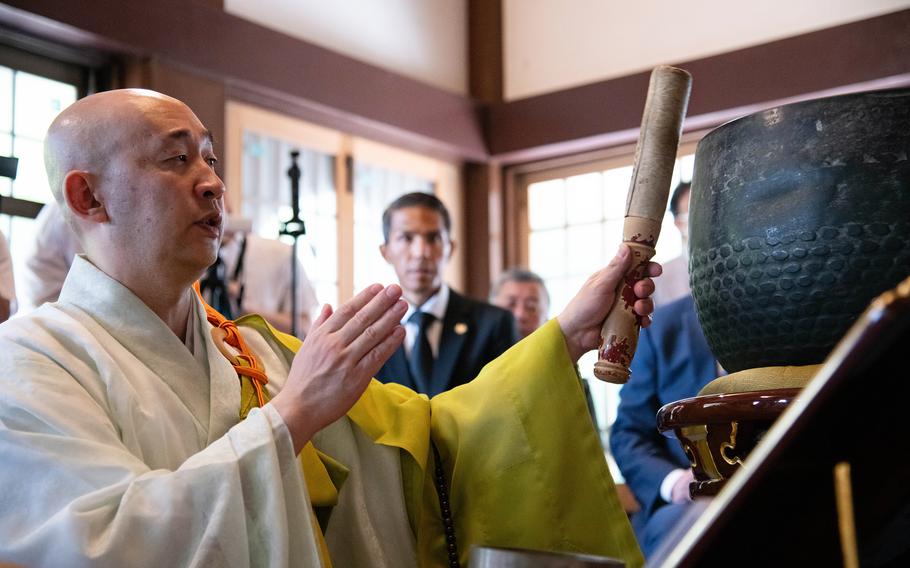
Buddhist priest Kounen Ujida chants during a ceremony honoring U.S. bomber crews from World War II at Aburayama Kannon Temple in Fukuoka, Japan, June 20, 2025. (Janiqua Robinson/Stars and Stripes)
FUKUOKA, Japan — Nearly 80 years after they were captured and killed in the final days of World War II, dozens of U.S. airmen were honored Friday with a solemn ceremony that also reckoned with the legacy of those who carried out their executions.
American and Japanese service members, historians and families of both the fallen and the executioners gathered for the sixth time at Aburayama Kannon Temple in Fukuoka to remember the B-29 Superfortress crewmen who died during bombing missions over Kyushu between June and August 1945.
The airmen had flown from Tinian, near Guam, as part of the U.S. campaign to topple Japan’s war industry. After their bombers were shot down or crashed, 44 airmen were reportedly detained at Western Army headquarters in Fukuoka prefecture.
Some were executed. Others were used in medical experiments. Several, including bombardier Robert Jeffries, were never found. His daughter, Nancy Jeffries Samp, attended the ceremony by video call from the United States.
A Buddhist priest led the service, burning incense and chanting the names of the 44 airmen in a somber tribute to lives lost far from home.
“In 1990, I began to research my father’s Army Air Force group and attend their reunions so I could learn more about him,” Samp said in a speech read during the ceremony. Her father served with the 505th Bomb Group and was declared killed in action nearly a year after going missing in February 1945.
Samp recalled attending a 2013 service in Japan in which she “began to feel the presence of mutual understanding between the people of Japan and America for the first time,” she said Friday. “An acceptance of each other as individuals who knew they couldn’t change the past but wished for peace in the future.”
The executions were carried out under Japan’s Enemy Airmen’s Act, enacted in 1942 after the Doolittle Raid. The law allowed the killing of war prisoners accused of bombing civilians, but trials were rare or nonexistent.
Friday’s ceremony also acknowledged two Japanese officers who took part in five of the executions and the legacy their families now carry.
Wataru Satano, whose father, Osamu Satano, executed one POW, joined the ceremony by video call. After the war, his father fled to avoid arrest but was eventually captured and imprisoned.
“When I turned 20, my father called me into a separate room and told me about his shocking experiences during the war,” he said, later adding: “We must pass on these memories to future generations and prevent another tragedy.”
Katsuya Toji said his father, Kentaro Toji, was ordered to execute four airmen and was sentenced to death, though the sentence was later commuted. While in prison, he wrote a poem asking, “Will my children ever meet the children of the airmen I had to execute?” Katsuya Toji said that meeting happened last year — and again on Friday.
“This is truly a testament to peace that transcends generations,” he said.
After his release, Kentaro Toji installed four Buddhist statues in his garden — one for each airman — and a fifth to honor their children. The statues were donated to the temple during Friday’s ceremony.
“War leaves deep scars, not only on the defeated but also on the victors,” Katsuya Toji said, adding later: “We must do our part to ensure that the friendship between our two nations continues and leads to lasting peace.”